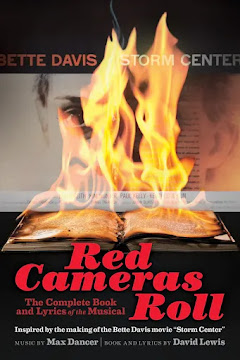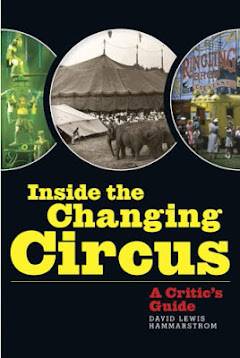
When I first encountered, or should I say wrestled with, the extravagantly overproduced book, Circus: 1870-1950, at the San Francisco Public Library, I was soon swept away by magnificent color photographs I'd never before seen, mostly of floats, costumes, performers and backyard scenes from the John Ringling North era. Such mesmerizing revelations of a circus reinventing its lure in top-of-the-line design art. I could not stop the turning pages.

Many, more likely most, of the more spectacular visuals (can you see a foreshadowing of Cirque du Soleil, above?), are the work of photographer Sverre O. ("Bex") Braathen, and they give this huge, narratively ineffectual volume a clear aesthetic reason for being. They thrill our circus fantasies, bring glory to the big top, especially to the one operated by Ringling-Barnum during the remarkable years of artistic innovation through the 1940s-1950s. In particular, they offer indisputable evidence of the genius of costume designer Miles White; secondarily, of the captivating midway face lifts created by famed industrial designer Norman Bell Geddes.
From whence these heretofore unseen images? I assumed, giving it no thought, oh, from Sarasota or Baraboo, of course. After all, isn't that where all circus illustrations come from?

No! Not anymore. Now, in breathtaking Braathen brilliance, a new gold mine of circus photography is coming to light from out of a place called Normal -- as in Normal, Illinois, home to Illinois State University. The golden goodies, and they number in the thousands, kids, reside in the Special Collections unit of the Milner Library. Their major contribution to the Taschen tome marks a virtual world premiere for Braathen. Before that, though hard to believe, the Kodachrome slides were only viewed when the photographer himself showed them to friends. (Braathan was an attorney by trade, avid circus fan and writer.) Occasionally, some would show up in Bandwagon. Here, through the outreaching generosity of Library Specialist Mark Schmitt, I am posting a sample of the magic.

Best of all, they are now coming to a computer near you, credit the good will of some fine and sharing folks at Illinois State's Circus and Allied Arts Collection, curated by Steve Gossard. You will be able to access a steadily increasing number of Mr. Braathen's shutter delights as they come on line. Here's your link to the inaugural parade:
http://tempest.lib.ilstu.edu/braathen.php

Go ahead, be dazzled. In the current issue of Bandwagon, Fred D. Pfening III, introducing a story written by Mr. Braathen's wife, Faye O., about their 2-week travels with Ringling-Barnum just before its last days under canvas in 1956, ranks the work of Braathen as "only a notch or so below the acknowledged masters of the field, Fred Glasier, Harry Atwell, and Edward Kelty." I'm not completely sure about the sanctity of those names alone. Looking back at old National Geographic magazine stories on circus that featured color plates, several other names standout that I've never heard of. Even Ringling flakmaster F. Beverly Kelley took some superb images that were published by NG. In later years, Ted Sato, serving a brief three- or four-year stint for Ringling, with a superb eye for composition, produced some stellar black and whites; he has yet, in my opinion, to receive the credit his marvelously composed frames truly deserve. But Pfennig, as I see it, is surely correct in placing Braathen near the top.

For color, clarity and the occasional well-framed shot, Braathen is now gratefully engraved in my brain. In essence, his work lends true star power to the Taschen tome, itself essentially a lavish photo showcase with no clear structure to speak of. Mr. Braathen appears to have been particularly adept at grouping performers together in the backyard. For the most part, his camera stayed out of the tent, owing to lighting restraints. I would love to see any action photos he may have taken, but there is no evidence so far that he flourished in this area.

What bothers me the most, among a number of textual sins committed by Taschen's editor Noel Daniel, is that, of the few photo sources acknowledged on jacket copy or in a brief preface, the name of Sverre O. Braathen, is nowhere to be found. Incredible ingratitude --- worse yet, blundering editorial oversight and/or ignorance --- for a photographer whose work gives this sprawling showcase a distinctive recurring luster. Moreover, it seems a crime that photo captions could not have included a code linking each to its respective source.

In one of his e-mails to me, notes Mr. Schmitt,"1/3 of that Taschen book is sourced from our Sverre O. Braathen collection, but we have enough images still to fill, say, 30 volumes set solely devoted to our collection."
Among the gold in Normal, Schmiit estimates they have 3000 COLOR Braathens of Ringling in the 1940s-1950s, approximately 400 of Cole Bros. And for every color shot, Braathen snapped four or five black and whites. He took "thousands" during the 1930s. This epic gold mine has lay unseen for decades.

This 1942 shot of the side show is so quintessential John Ringling North -- the gaudy yet sharply atypical color schemes deliciously seductive. Even theatre critic Brooks Atkinson that spring reviewed the acclaimed Madison Square Garden premiere and issued a raving salute in a special Sunday New York Times piece. The circus of Ringling North had enjoyed a dream season the year before, greeted by one turn-away crowd after another. It's easy to understand how the public was so drawn to and infatuated with the revamped look of the show, from air conditioning units that barely worked to a performance of rare beauty. "It's the best costumed, best lighted and best presented circus in the big show's history," declared The Billboard.

"We also have Arnold Riegger's negatives," writes Schmidt. "Frank Ball's images,and what seems like an endless well of scrapbooks, and loose photographs, not to mention Charles Clark 1922 RBBB images. Thousands upon thousands."
Move over, Baraboo and Sarasota. Normal, you're on.

All photos used with permission from Illinois State University's Special Collections, Milner Library.
From the top:
Antoinette and Arthur Concello
Pocahontas float from "The Good Old Times" spec, Ringling-Barnum, 1952
Midway and entrance, 1941
Henry Ringling North, 1941
Showgirl in tiger spec number, 1944
Lou Jacobs, 1941
The Cristiani Family of bareback riders, 1941
Ringling flat cars loaded, 1941
Side show makeover, 1942
"Hoop De Doo" finale, 1956
Showgirls in spec, 1954
Below: Faye Braathen, Burt Lancaster, and Sverre Braathen.

Luckily for me, a few of Braathen's wonderful images appear in my new book, Inside the Changing Circus: A Critic's Guide, though, so as not to falsely tease you, they are in in black and white -- all except for the wonderful image of the Ringling marquee and ticket wagon on a Canadian lot in 1953.
Originally posted 9.10.10






















3 comments:
Dave,
What a great way to start off a weekend with your post today.
I first saw these in the $200 circus book and then in the Bandwagon.
Yes, Braathen was a great photographer and thank goodness used good old Kodak Kodachrome the world's best film.
I still shoot Kodachrome but it is coming to an end as of De. 31 as it will not be processed anymore.
The film has been around since 1935 and the colors are still brilliant.
You asked why he did not shoot in side the big top. The asa film speed in the early years maybe 8 and then 25 later on in the 1950's.
With that speed of film you got to have tons of light to get pictures.
But outdoors Kodachrome ruled.
Ektachrome slides will fade in time but not Kodachrome.
When DeMille shot Greatest show on Earth he had to go to Technicolor to get a faster speed film to shoot the movie.
As Kodachrome and Technicolor are very simular processes as they both start as a black and white process.
Dave, thank you again so much for these beautiful color photos of the way it used to be. As Kodachrome adds to the effect and very different from black nd white.
Harry Kingston
Along the lines of "blundering editorial oversight and/or ignorance" check carefully at the people listed in the photos. On picture listed as Damoo Dhorte and Walter Klauser(bear trainer Klausers Bears) is actually Dhorte and one of his grooms.
Most astonishing to me is a photo of Betty Hutton playfully posing in front of an elephant (probably while on the lot making the movie, Greatest Show on Earth); she is merely identified as "a circus fan"
Post a Comment